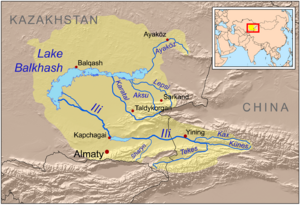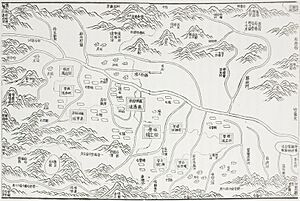Ili River facts for kids
Quick facts for kids Ili River |
|
|---|---|

Ili River
|
|

Map of the Lake Balkhash drainage basin showing the Ili River and its tributaries, the Kash mistranscribed as 'Kax'
|
|
| Country | Kazakhstan and China |
| Physical characteristics | |
| Main source | Tekes and Künes rivers Tian Shan |
| River mouth | Lake Balkhash |
| Length | 1,439 km (894 mi) |
| Basin features | |
| Basin size | 140,000 km2 (54,000 sq mi) |
| Official name: Ili River Delta and South Lake Balkhash | |
| Designated: | 1 January 2012 |
| Reference #: | 2020 |
The Ili River is a long river that flows through Northwest China and Southeastern Kazakhstan. It starts in the Xinjiang Uighur Autonomous Region in China and ends in the Almaty Region in Kazakhstan.
This river is about 1,439 kilometres (894 mi) long. A big part of it, 815 kilometres (506 mi), is in Kazakhstan. The Ili River begins where two other rivers, the Tekes and Künes, meet in the Eastern Tian Shan mountains. It collects water from the area between the Tian Shan and the Borohoro Mountains. When the Ili River reaches Lake Balkhash, it forms a huge delta with many lakes, marshes, and plants.
Contents
What's in a Name?
The name of the Ili River likely comes from the Mongolian word il, which means "open" or "clear." This might describe its wide valley. Some people think the name comes from Persian words meaning "big river" or "murky," referring to how the water looks where the Kunges and Tekes rivers join. Some Uyghur scholars believe it comes from the Uyghur word il, meaning "hook," because of the river's shape. Tourist websites sometimes say it means "shimmering" in Mongolian.
The Ili River was first mentioned in a dictionary of Turkic languages called the Dīwānu l-Luġat al-Turk, written between 1072 and 1074. In this book, the author described it as a very important river for Turkic tribes.
The Ili River in China
The upper part of the Ili Valley in China is surrounded by mountains. The Borohoro Mountains are to the north, separating it from the Dzungarian Basin. To the south, the Tian Shan mountains separate it from the Tarim Basin. This area was very important for the Qing government in Xinjiang during the late 1700s and 1800s. It was even controlled by Russia for a while, from 1871 to 1881.
Today, this region is part of China's Ili Kazakh Autonomous Prefecture. The main city there is Yining, also known as Kulja. It's located on the north side of the river, about 100 kilometres (62 mi) from the border with Kazakhstan. For a long time, until the early 1900s, the city was called by the same name as the river, Ili. On the south side of the river is Qapqal Xibe Autonomous County. This area is home to many of China's Xibe people, who moved there in the 1700s.
There are several dams on the rivers that flow into the Ili. For example, there are at least two dams on the Kash River in Nilka County. There are also dams on the Tekes River, another tributary of the Ili, including the Qiapuqihai Hydropower Station in Tokkuztara County.
The Ili River in Kazakhstan
The Ili River is the most important waterway in the Balkhash-Alakol Basin in Kazakhstan. The part of Kazakhstan that the Ili and its smaller rivers drain is called Zhetysu, which means 'Seven Rivers' in Kazakh. In Russian, it's called Semirechye, meaning the same thing.
A large power plant, the Kapshagay Hydroelectric Power Plant, was built on the Ili River between 1965 and 1970. This created the Kapchagay Reservoir, which is an artificial lake about 110 kilometres (68 mi) long. This lake is located north of Almaty.
About 20 kilometres (12 mi) downstream from the reservoir, you can find Tamgaly-Tas. This is a protected area with ancient rock drawings. The name Tamgaly means "painted" or "marked place" in Kazakh, and Tas means "stone."
The Ili Delta: A Wetland Wonderland
The Ili River flows into the southeastern edge of Lake Balkhash. Here, it forms a huge delta that covers about 8,000 square kilometres (3,100 sq mi). This delta is located between the Saryesik-Atyrau Desert and the Taukum Desert. A large part of the delta, 9,766 km2 (3,771 sq mi), is a special protected area called a Ramsar Site.
This amazing wetland is home to 427 types of plants and 345 types of animals. Many rare animals live here, such as the Dalmatian pelican, goitered gazelle, marbled polecat, white-headed duck, red-breasted goose, and ship sturgeon. The delta is also popular for fishing, especially for wels catfish, which can grow to be very large, over 300 lb (140 kg). The Ili River is the third-largest river in Kazakhstan in terms of how much water it carries.
The government of Kazakhstan plans to combine three wildlife sanctuaries in the delta (Balkash, Karoy, and Kukan) into one big National Park. The delta was once a home for the extinct Caspian tiger until 1948. There's a plan to bring back the Siberian tiger to the delta, as it's a close relative of the Caspian tiger. The delta still has a large population of wild boar, which was a main food source for the Caspian tiger. There are also some roe deer. In the drier areas south of the delta, you can find saiga antelopes and goitered gazelles.
Scientists are also thinking about bringing back other animals that the Caspian tiger used to hunt, like the Bactrian deer and the Asiatic wild ass.
Fishing in the Ili River
Fishing is very popular on the Ili River, especially for catfish. These are some of the biggest fish in the water. They can grow up to 5 meters (16 ft) long and weigh as much as 300 kilograms (660 lb) (about 660 pounds)! Smaller ones usually weigh between 50–100 kilograms (110–220 lb).
Tributaries
The Ili River has many smaller rivers that flow into it. These are called tributaries. Here are some of the main ones, listed from where the Ili starts to where it ends:
- Tekes
- Künes
- Kash
- Khorgos
- Charyn, famous for its amazing canyon
- Chilik
- Talgar
- Kaskelen
- Kurty
Images for kids








